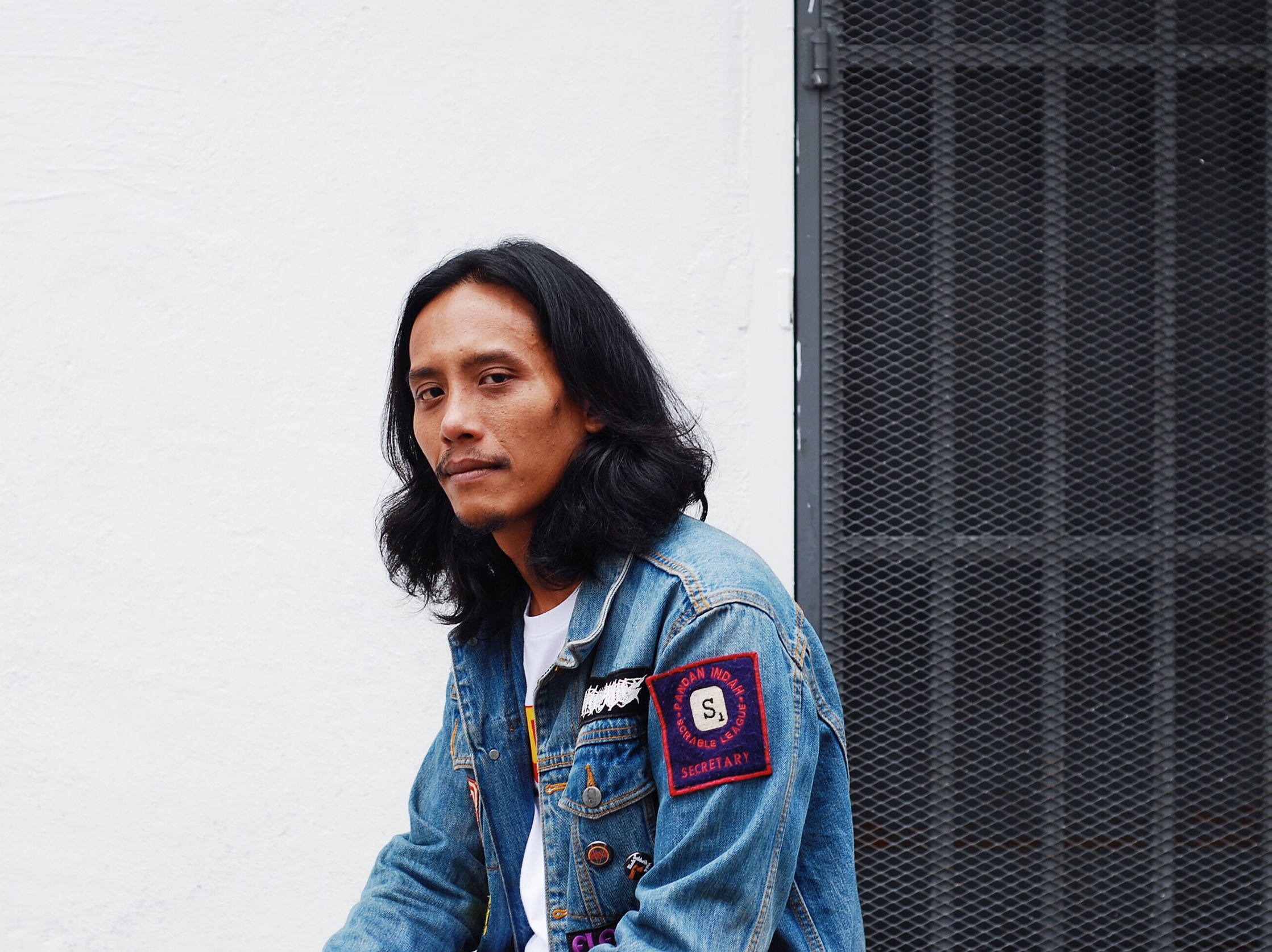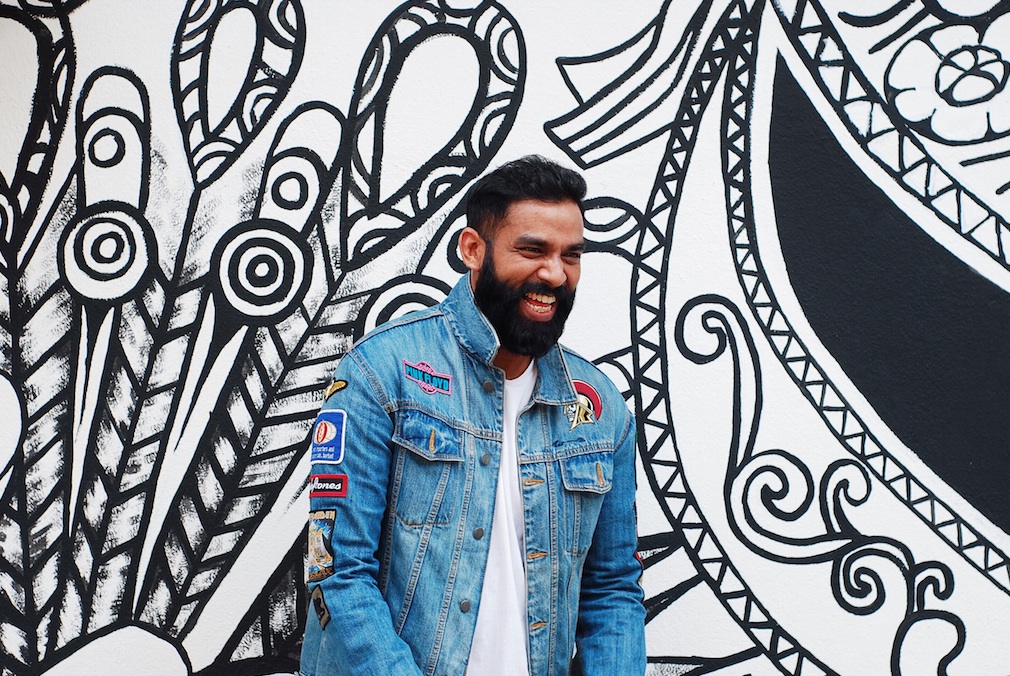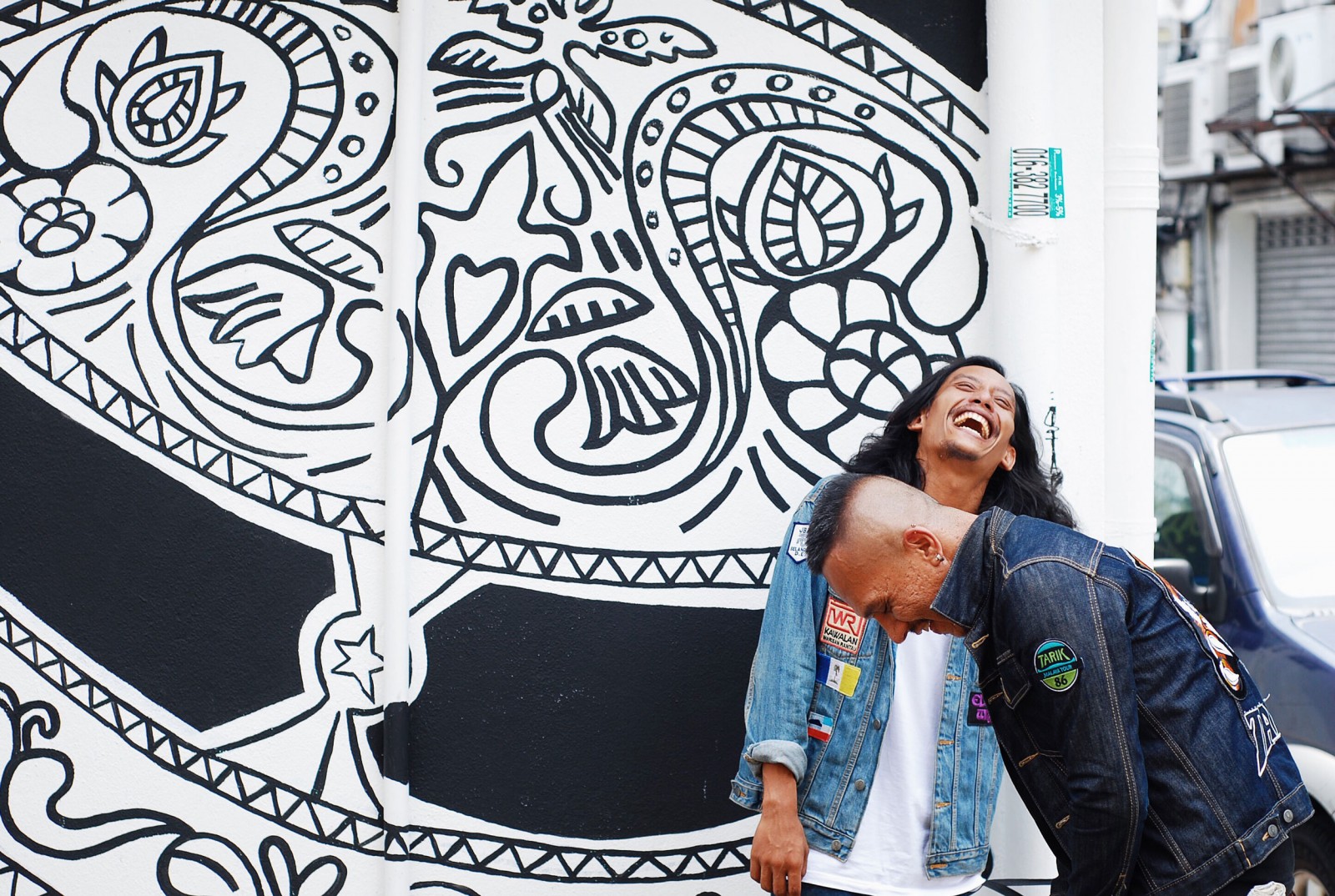Afiq Iskandar: “The first Prime Minister of Malaysia [of] non-Malay, non-Bumi [descent] is probably wearing Tarik right now.”
 Thirsty for JUICE content? Quench your cravings on our Instagram, TikTok and WhatsApp
Thirsty for JUICE content? Quench your cravings on our Instagram, TikTok and WhatsApp
Almost half a decade ago, Tarik Jeans captured Malaysia’s attention after its release of a varsity jacket that had a mamak illustration that read ‘Who’s Your Mamak?’ on its back. The probability of this particular apparel being picked up for the humour that was patched onto it was high, but beneath its suede surface, Malaysian-made products or apparels that embodied any sort of essence to Malaysia soon became somewhat of a patriotic symbol.
Over the past few years, there has been an increase of retail brands that have taken it upon themselves to emulate the same formula for themselves — if Megadeth wrote a song for a movement such as this, it’d be ‘Patriotism Sells, And Everyone Is Buying It’— but unfortunately many end up appearing more gimmicky than genuine; a hard balance to achieve if the brand’s core objective is blear. Despite the growing fashion scene in Malaysia and internal changes, Tarik Jeans have not fallen off of their pursuit of cultivating a healthy denim scene in our community.
The rebirth — so to say — of Tarik Jeans happened earlier this year when the brand appointed Jiman Casablancas as its Creative Director, and with its debut show at Kuala Lumpur Fashion Week (KLFW) ’16, it marked the first time a denim brand had been shown on a runway in KL. JUICE caught up with the core members of Tarik Jeans — founder Afiq Iskandar, creative director Jiman, and financier Romesh — to discuss trend forecasting for denim, education on denim, and politics, somehow.
Tell us about your individual roles in Tarik.
Afiq I’m the person who founded the brand and I ran it for the first first years with a bunch of… I had a few teams but it’s always changing.
Jiman Like Destiny’s Child (laughs).
And you pulled a Beyonce?
A Yeah, I’m the Beyonce. I’ve worked with Jiman on a couple of occasions — especially during the Nusantara Denim period, that’s when we first had a chance to work together, then in 2015, Kelly Rowland — aka Romesh — came into the picture (laughs). It was after that we started strategising again, then Jiman came onboard, so that’s when everything [for] KLFW ’16 started.
“[Jiman] called me and said, ‘Afiq, I just came back from KLFW and I tak nak pergi dah, I’m so disappointed.’ So, I said, ‘Okay, let’s show them how it’s supposed to be done.'” – Afiq
So, this partnership has been somewhat of a longtime coming?
A I’ve asked Jiman to be part of the team dah lama but Jiman couldn’t commit. But it was on the third day of KLFW in 2015, he called me and said, “Afiq, I just came back from KLFW and I tak nak pergi dah, I’m so disappointed.” So, I said, “Okay, let’s show them how it’s supposed to be done.” And we did that in 2016.
J I had to put my money where my mouth is.
A The beautiful thing about it was that we didn’t have a lead at all — KLFW’s [founder] Andrew [Tan] didn’t know who Tarik was but we managed to get ourselves [a meeting] there in early January.

How was that?
J We took the presentation quite seriously.
A Yeah, we hired a model who was hiding in the washroom and it was [only] during the presentation that the model came out to surprise Andrew (laughs).
J And KFLW had their whole team who came down to watch us, and the fact that they’ve never had a denim brand to show before, that excited them as well. But Tarik has a long history.
“… it used to bother me how we [Malaysians] are always fascinated with what’s popular over there but they’re interested in [our culture].” – Afiq
Speaking of history, did you have an idea of what the Tarik Jeans person would be like when you conceptualised the brand?
A Luckily for me, I have a father who travels a lot, so I got to meet many people from different countries, and it used to bother me how we [Malaysians] are always fascinated with what’s popular over there but they’re interested in [our culture] – i.e. batik – I think it’s because of the internet as well, we could see glimpses of people starting to realise that. Because the internet gave sort of like an inside look of the thought process of how it’s done over there, and a lot of the brands look back into their own culture, and it’s unfortunate that our creative process involves looking at their culture instead of ours. I guess it sort of grew because that local aspect is in everyone – it’s just a matter of tapping into it to activate it.
What part of the local aspect did you want to tap into?
A When I first started the brand, it was a nationalistic brand… but as time went by, we started to realise it’s proximity; it’s immediately loving the people around you and lucky for us, we are Malaysians, we’re born in a country filled with amazing people, it’s just that we don’t spend enough time looking at ourselves to appreciate what we have because we’re too busy.
So, in your 30 years of living, what’s your perception of the Malaysian community?
A As much as I would not like to say this, we’re really oppressed.
In what sense?
A In every sense, but let’s discuss the creative aspect — yeah, we’ve been colonised and all that, but it’s unfortunate to see the way we look at pop culture, the way we look at this whole creative thing is still Western-oriented, and I think the media that we have here — especially the mainstream ones — I think they’re very irresponsible in cultivating our culture.
J Government is also to blame.
Romesh And the media can’t do much because it goes back to media ownership. A lot of mainstream media outlets are government owned, but I think a lot of people have taken it upon themselves to speak up to where the government and mainstream media do not.
A We know that the media is designed to brainwash people, right? (Laughs) And in Malaysia it’s being done very irresponsibly. As a Malaysian-Malay, not many see it, like we’re very racist, we’re very open about it, and then not many Malays are brave enough to speak that out. So, I hope that Tarik can be a brand that is outspoken — we are trying to be that brand. I once tweeted, “The first prime minister of Malaysia [of] non-Malay, non-Bumi [descent] is probably wearing a Tarik right now.”

What was the response to that?
A It was mixed. Some Malay friends who were always behind the “We should be united” idea were very, “Uh… I don’t necessarily have to agree with you.” So, we’re [still] trying to be that brand.
J Which is why I’m drawn to Tarik, because of the spirit that it carries. When we were discussing what should be the logo we project onto the screens at both sides of the stage [during KLFW], I immediately said put the Tarik mamak there because that’s us. When else can you see a Tarik mamak at a fashion event like that? Be proud of being Malaysian.
What are Tarik’s roots?
A Love. Immediately loving the people around you and loving who you are. The longer we do this, the more that we realise there’s no point in being all patriotic because we’re claiming our place, yes, but we’d also like to participate in the global community. And Jiman always says…
J Think global, buy local.
A We are all on the same page because to us, the most global person is not the person who knows everything that’s outside, it’s the person who knows both; I can talk Vetement with you but at the same time I can discuss Ezzati Amira with you.
Essentially, to be as conscious as you can.
A Exactly. I think a person like that would be good enough to participate in the global culture.
Jiman, in your experience after delving into retail, branding, and PR, what is the Malaysian consumer like to you?
J I think it wasn’t cool to wear local brands before, even in the ‘90s…
“I can count on one hand how many local brands that I bought and even then, when you wear it, there’s no sense of pride? It’s kosong.” – Jiman
Why do you think that is?
J I think the internet has had a lot to do with it. Even for me, I can count on one hand how many local brands that I bought and even then, when you wear it, there’s no sense of pride? It’s kosong. There was no sense of emotion attached to it as opposed to now when you buy it, you want to let people know that you’re wearing it. Of course, social media – like during Hari Raya – you want to tag the designer or brand that you’re wearing while holding a Prada bag. You wear it because you want to wear it, not just because you want to support your friend.
A It’s a bit tricky — it takes a bit of creativity to put it together because it’s not catalogue, it’s not something you see on Pinterest, then you emulate top to bottom, there’s actually a thinking process that you have to go through. Yeah, it can be difficult to consumers who are like the iPhone, [coffee table] book buyers. If you can buy RM600 Kronos jeans, you can easily pick two pairs of Tarik. A lot of people have agreed that the construction is on par, if not better [than other denim brands].
R Of course quality has a huge part to play in this. Malaysian brands have had to up their game and I’m proud to say that there are many brands that are on an international level right now, so in that sense, as long as you present yourself with international quality, I don’t think there’s anything stopping you.
Most definitely.
A Part of our value proposition is that Malaysia has reliable brands in terms of quality, which then trickles to our production. We are always on the hunt for the best and the best Malaysians can get because that’s what we are set out to do. Our production is done in Bandung and we get a lot of questions regarding that, but in Malaysia, the denim scene is still very, very new.
R We don’t have a community here.
A Not just that, but in terms of production facilities [we don’t have it, whereas] in Bandung you could easily get a few factories in one location. There are factories here in Malaysia but in terms of quality and price, it’s just not there yet, but we’re not ruling it out. We are ready to help, because we have access to fabrics, we are ready to help grow the industry and when the time comes, we will be more than happy to produce here. We are trying to establish a network of Southeast Asian denim [brands], so we need those kinds of things. Besides that, quality control, sourcing of materials, those are the things that we really, really look for.

What’s the price range for Tarik’s products?
R Our retail price is from RM229 to RM600.
Ah, so, standard denim prices.
A For someone who gets it, it’s standard.
Then, how do you introduce it to someone who doesn’t understand the denim culture?
R For now, I must say it’s a bit difficult because there’s a lot of education that needs to come into play. A lot of people don’t understand the significance of the effort, time, and work that it takes to selvedge denim, and why it’s so coveted to people.
A And after doing this for so long, what we have come to realise is that that’s what we don’t have yet, unlike Indonesia and Thailand where you see high school kids are already wearing selvedge – and you can speak denim with a huge majority of them unlike over here. So, as a Malaysian denim brand, part of our responsibility is to educate; to create the knowledge so that Malaysia can be on par with others. Actually, next year, we’re looking to having ground events…
R I think looking at it [the denim culture in Malaysia], we don’t have a healthy one, it’s hard for us to grow and it’s hard for us to introduce new things because people don’t understand, so I think it’s a two-part thing for us where we have to introduce and champion [denim culture].
Individually, could you justify what makes your brand different in comparison to what’s available via fast fashion brands?
A It depends on how personal a person takes his or her relationship as a consumer.
J How can you have a relationship with H&M jeans?
A To make it seem more tangible, like whenever we look at our barang, we judge it based on the soul it has.
J Yeah, if it’s cukup garang or not.
A If you look at something that’s mass-produced, mana soul dia? Whereas when we do it, we make sure that on its own, it has life. Does it breathe by itself? We got that from Helmut Lang because that’s his philosophy.
J [When] H&M started doing collaborations, I think it realised that people needed to have a sense of connection with their brand, and there’s not enough of a connection with H&M alone, so they needed collaborations to happen. My Alexander Wang x H&M piece is as good as a Wang, so I always refer to it as a real Wang, because when I travel with it overseas, people comment on how authentic it is. So, immediately you know that it’s H&M, but emotionally, it’s a Wang.
“We are proud to go to events and see Tarik on people who are not dickheads — [for] lack of a better word — we get smart, quality consumers.” – Romesh
How would you describe the Tarik consumers then? Who are they?
R I think we get the guys that are apart from the norm. We are proud to go to events and see Tarik on people who are not dickheads — [for] lack of a better word — we get smart, quality consumers.

What’s a healthy denim community to you?
R One that isn’t afraid to try local brands and is not limited to what they know by media. We definitely are working on making the next two, three years of Tarik solely towards educating and creating a healthy community.
J The easiest analogy would be, during Hari Raya, if I wanted to buy jeans, my mother would tell me to buy Levi’s because I could wear it for a long time. That is the perception that we want to change; hey, we’re here too, buy it for one Raya and see whether you like it or not.
A At this moment — Rome will not agree with this — we try not to focus too much on financial profit, although we are starting to in order to sustain ourselves, but put forth the education and what the brand stands for first because we believe that if we work hard enough, it’s going to come later. We’re not a brand that’s out here to make money. We’re looking to solving the problems and then making the money.
R One problem I think Tarik has already solved is the Malaysian guy cut. We have got that down. That’s why I wanted to join the brand. 9 out of 10 guys you put in a pair of Tarik Jeans will say, “Fuck, my ass looks good.” For a dude to say that… Malaysian guys don’t have an ass lah — chances are they don’t — so, we make them look good lah.
“… it’s okay for us to release jeans according to trends but when the trend dies, we are still around.” – Afiq
Poor Malaysian boys are going to feel more conscious about their lack of ass. But on another note, how does the team forecast upcoming trend when working with a material like denim?
A One of the earliest things I realised as a branding person is that I made sure that Tarik was a brand and not a trend. We came out during the denim hype but I made sure that we existed as a brand; it’s okay for us to release jeans according to trends but when the trend dies, we are still around. A brand is aware of trends, but there are plenty of local brands that aren’t aware of that, so, they fully commit to a trend and then the time passes by and they’re like…
J … “What are we about, ah? We don’t know.” That’s why for me, as an agency guy, I always think of Tarik as a person. What music does he listen to? What movies does he watch? Where would he go? You treat the brand like an individual.
What would the Tarik guy listen to?
A The Russian composer that remade the P. Ramlee song, which we used for our show at KLFW.
J I grew up in a gamut of crazy music around the house and one of it is Hindustan music — I never really talk about this — my mother listens to so much Hindustan music like [the OSTs for] Sangam and Bobby, I could [sing-along] from one song to another.
A Jiman listens to a lot of cool shit. He burned a CD of Malaysian pop artistes from the ‘80s [for me] — my mom stole it.
J I think that it’s important for us to listen to this. I hate it when I have friends who claim to be fans of Sheila Majid — name me one Sheila Majid song?
A + J ‘Sinaran’!
J You’re not a fan. Same like when I wear an Iron Maiden t-shirt lah (laughs). So, if I had to pick one, it’d be the soundtracks to Sangam and Bobby.
R For me it’d be Love Me Butch or Nakedbreed.
A Those are the things I feel that make us more Malaysian than the 1Malaysia campaigns.
That is to distract people.
A All the advertisements with the one Malay, Indian, and Chinese together…
“I think Rome and I disagreeing on the Butterfingers reunion is more Malaysian than the GST advertisement.” – Afiq
We know it’s to fill a quota.
A I think Rome and I disagreeing on the Butterfingers reunion is more Malaysian than the GST advertisement — where the Chinese guy had to take the advice of a Malay dude about GST, then the Indian guy came in and was like, “Ha, macam ni lah negara kita boleh berjaya!”
There was more cheese in that advertisement than on pizza. So, what are the plans for Tarik in 2017?
J We’re levelling up next year. We have a show in March that we’re still discussing — we haven’t decided what’s going to be in it, but we have the big idea which requires a lot of research and how we want to manipulate denim, so that’s happening.
R Apart from that, I think next year’s [focus] is going to be on introduction into proper denim and education because we’re going to be releasing a lot of selvedge and premium denim, so together with that, the two-part thing must include the education and the building of the community just so we can get it out to the right people.
A This year was about getting to the audience and next year is to focus on keeping them and making sure they stay with us before we expand some more.
R This year, it was really about reintroducing Tarik again.
J Yeah, because people are constantly asking for what’s next — it’s tiring sometimes because you want to please people but you don’t want to tire yourself and you want that longevity, the hardest part is to maintain that. We are going towards that, we have garnered new fans, so it’s about making sure they stick with us.

Keep up with Tarik Jeans at @TarikJeans or browse through its webstore via www.tarik.my.





